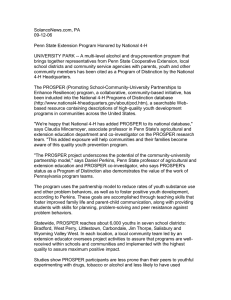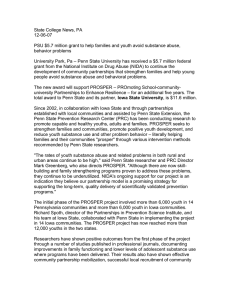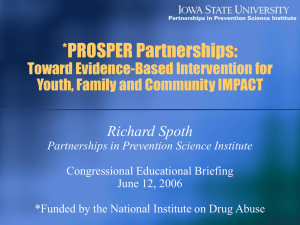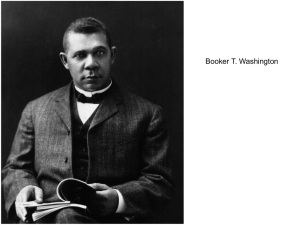PROSPER: Lessons Learned About Evidence-Based Practice in the Real World
advertisement
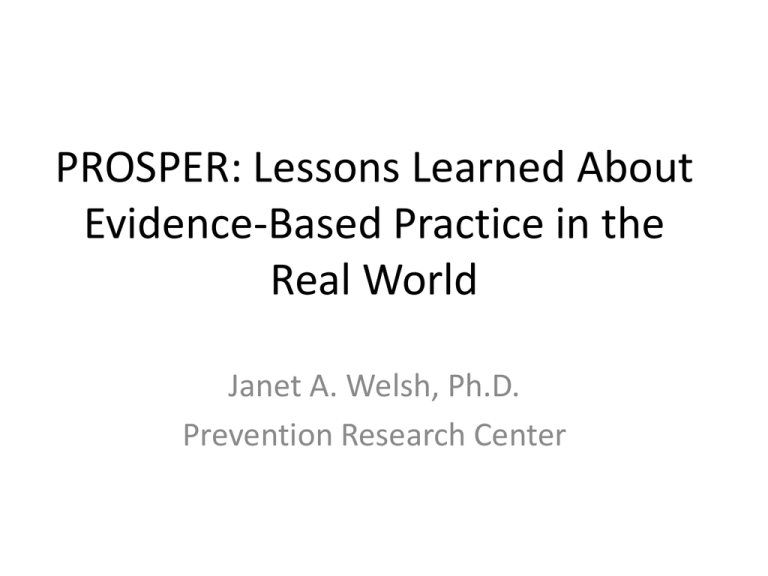
PROSPER: Lessons Learned About Evidence-Based Practice in the Real World Janet A. Welsh, Ph.D. Prevention Research Center The Challenge • Evidence based practices (EBP’s) to reduce disorder and promote public health currently exist, but are underutilized in community settings • Even when EBP’s are adopted, they are often not sustained and rarely implemented with quality The Questions Can EBP’s be infused into community settings where they are consistently implemented with high quality and sustained? AND If so, does this do anybody any good? PROSPER 101 PROSPER began in 2002 as a joint endeavor between Penn State and Iowa State University PROSPER innovation included using the the Cooperative Extension System (CES) at Penn State and Iowa State to diffuse evidence-based prevention programs throughout those two states. Extension became the linking agent between communities implementing programs and prevention researchers at universities with expertise in implementation science Design • RCT, with 28 communities across two states, randomized to intervention or control conditions • 7 intervention and 7 comparison communities per state • Data collected from 2 cohorts of 6th grade youth (2003 & 2004), for an N=11,000 • Intervention communities received the following: – Evidence based family program (SFP:10-14) – Evidence based school program (3 choices) – Ongoing, proactive technical assistance (prevention coordinators) – Full financial support for 2 years, followed by a gradual withdrawal of funding – Implementation monitoring & feedback Data Collection All youth were administered a survey that assessed the following: – Substance use patterns for multiple substances – Substance use attitudes, perceptions, beliefs – Problem behaviors (i.e., delinquency) – School bonding – Peer influences – Parental monitoring – Parent-child relationship quality & communication • A subset of cohort II youth (N=1200) participated in more intensive assessment, including: – Parent-child observation – Parent interviews – Youth interviews – Analysis of school records • Data were first collected in the Fall and Spring of 6th grade, and annually thereafter until students graduated from high school • Cohort II subsample was followed into their young adult years (ongoing!) • PROSPER focused initially on substance use prevention with middle school students. • Communities were initially offered a menu of evidence-based prevention programs, including: – – – – – SFP: 10-14 Guiding Good Choices Project Alert Life Skills Training All Stars • Later, PROSPER sites were offered the option to add an elementary school program as well, and in PA several sites selected the PATHS program How Does PROSPER Work? • Each PROSPER community has a local team, which is a coalition made up of local stakeholders. Teams have about 8-10 people on them and can include (but are not limited to) the following: – – – – – Public school representative Mental health agency representative Substance use agency representative Parent representative Youth representative (2 or more) PROSPER Trademarks • The use of high quality, evidence-based programs • Ongoing monitoring to assure high levels of implementation quality • Ongoing technical assistance to promote sustainability • Using data to inform decision-making about prevention programming & local priorities What Do PROSPER Teams Do? • PROSPER teams are responsible for all aspects of EBI implementation in their communities. This includes: – – – – – – SFP recruitment Hiring, training, and supervision of SFP facilitators Implementation quality monitoring Publicity and marketing for PROSPER Resource generation to support programs Communicating with stakeholders about PROSPER’s impacts in the community • Teams meet about once per month • Local CES educator serves as the team leader, but all members participate • Teams receive TA as needed from Prevention Coordinators • PROSPER Team activities are very focused around the following issues: – High-quality implementation of EBI’s • Training of facilitators • Recruitment of families • Monitoring of programming quality – Revenue generation for programming – Communication with school personnel and community stakeholders Sustainability Strategies • PROSPER sites received full funding f0r all team activities, programming and TA for the first two years • For the next 2 years, they received partial support • For the past 6 years, they have all fully sustained their programming using resources they have generated locally Pennsylvania Funds Distribution $250,000.00 • $33,665.73 $200,000.00 $22,418.55 $68,265.43 $150,000.00 $24,348.15 $25,140.95 $100,000.00 $189,762.83 $145,870.87 $3,833.03 $108,773.61 $107,703.58 $87,512.78 $50,000.00 $65,179.70 $0.00 AY0405 AY0506 AY0607 AY0708 Total Funds InKind Dollars AY0809 AY0910 Where do sustainability funds come from? • Local Sources: Businesses, school district, team fundraisers – Community yard sale – 4-H Milkshake sale – Car washes • County Sources: Collaboration with local organizations interested in prevention, including – United Way – Children & Youth Services – Mental health or substance abuse prevention agencies • Foundations: – Blue Ribbon – Huffman Family Trust – Carlisle Health & Wellness • Local Congressional leaders: – WAM – discretionary funds • Federal Sources: – CYFAR – U.S. Department of Agriculture • State Sources – PCCD – Weed & Seed Sustainability: Lessons Learned • Every community’s experience is unique, but the one thing they all have in common is the need to plan for sustainability in advance – Seek expertise in marketing, branding, and community positioning Know Your Stakeholders! In order to sustain your programs, you need to mobilize your stakeholders and understand what is important to them. • • • • • School District? Substance use agency? Local Businesses? Local Police? Children and Youth Services? Sometimes stakeholders want personal testimonials, other times they want hard data Longitudinal Outcome Data for SFP 1 First Time Proprotion Trajectory for ISFP Condition Trajectory for Control Condition 0.8 0.6 0.4 0.2 0 0 months 6 months 18 months 30 months 48 months 72 months (Pretest) (Posttest) (Grade 7) (Grade 8) (Grade 10) (Grade 12) “How to listen together to solve problems, knowing to follow through with consequences to teach them (not understanding what my child is going through)” MONEY TALKS Results— Delayed Onset of Alcohol Use Leads to Cost Savings Partnership-Based Strengthening Families Program: Benefit-Cost Ratios Under Different Assumptions 13 Dollars Returned 11 $11.34 $9.60 $7.86 9 7 5 3 1 *Actual Study conditions 1 more case prevented/100 1 less case prevented/100 *Study Data indicate $9.60 returned for each dollar invested under actual study conditions Source: Spoth, R., Guyll, M., & Day, S. X. (2002). Universal family-focused interventions in alcohol-use disorder prevention: Cost-effectiveness and cost-benefit analyses of two interventions. Journal of Studies on Alcohol, 63(2), 219-228. • Have a variety of materials available – prepare for the 1-minute, 5-minute, and 15 minute presentation • Do you have an elevator speech? Please visit our websites at... www.prevention.psu.edu www.ppsi.iastate.edu
